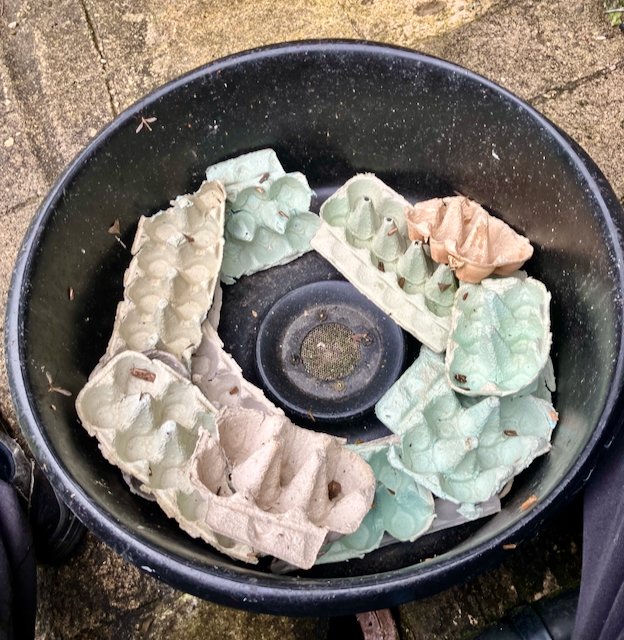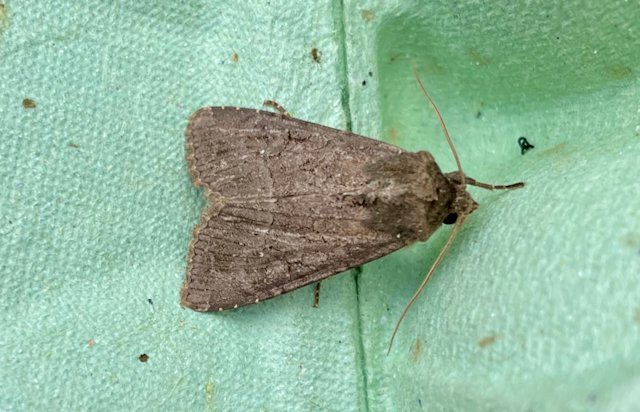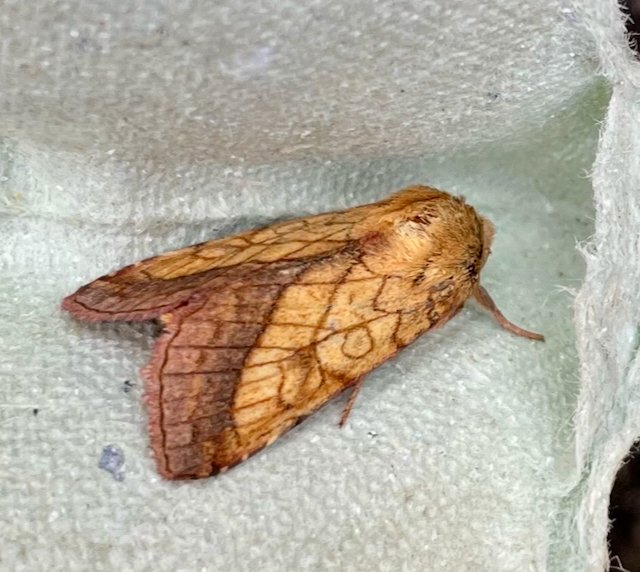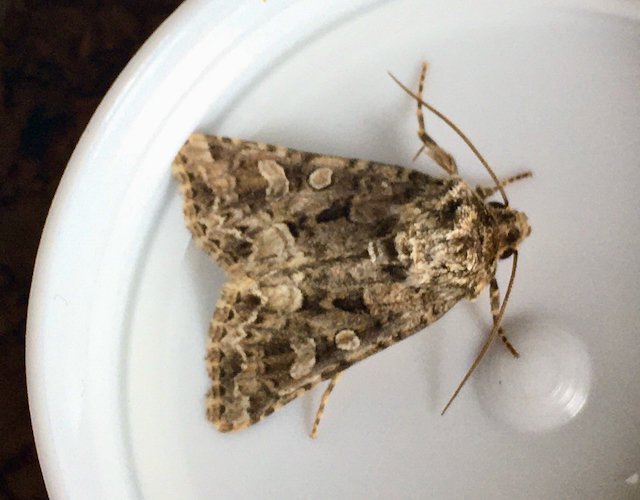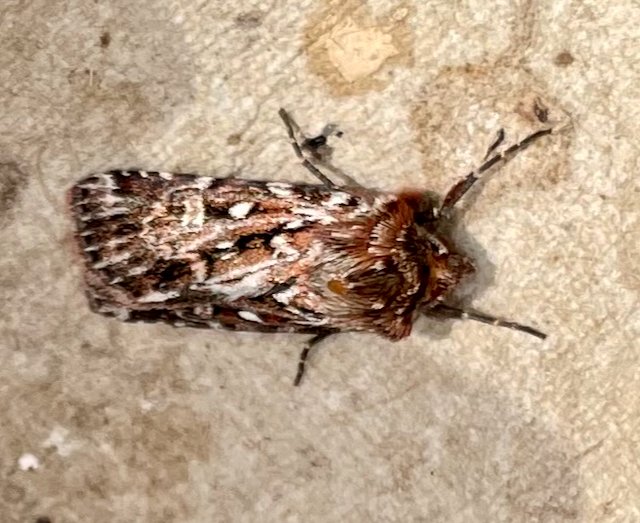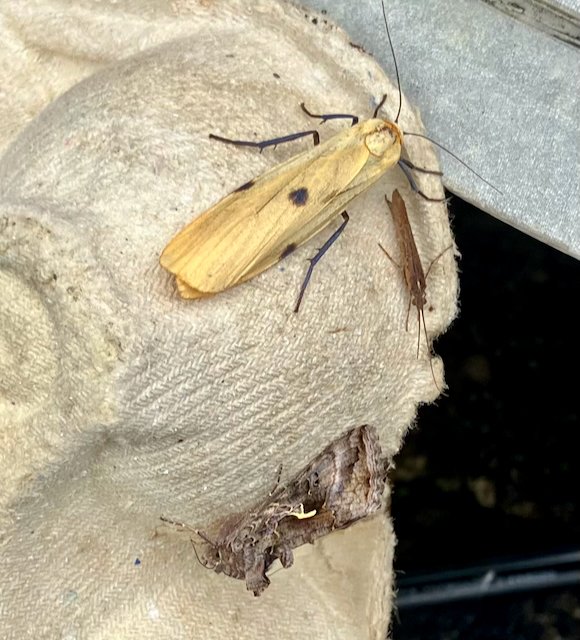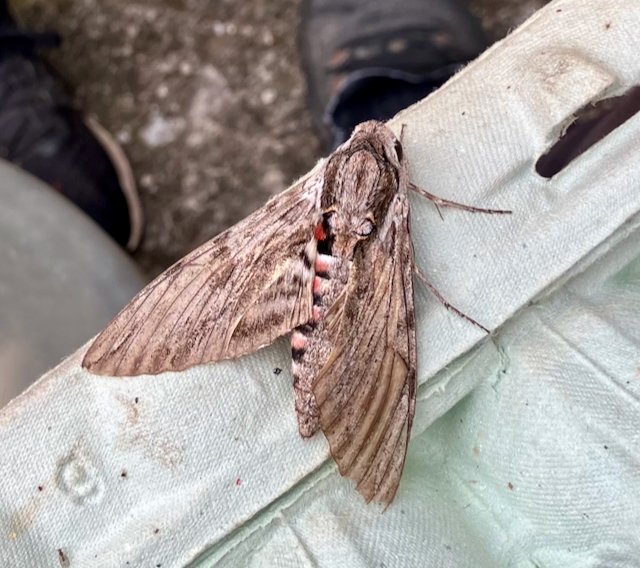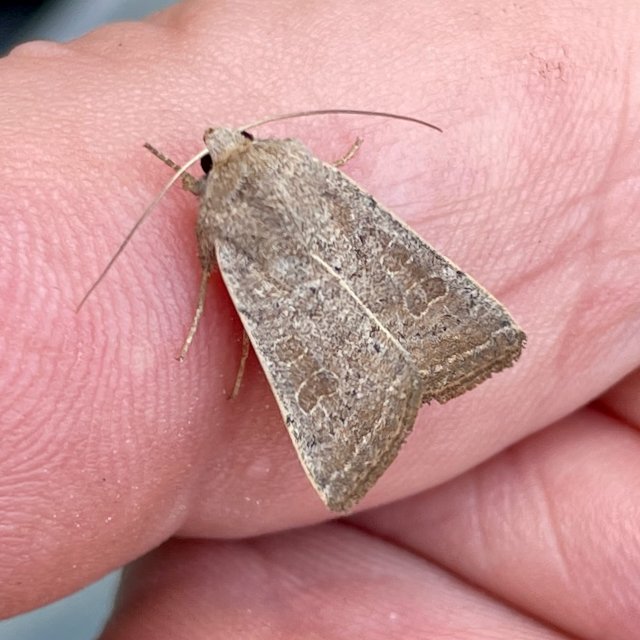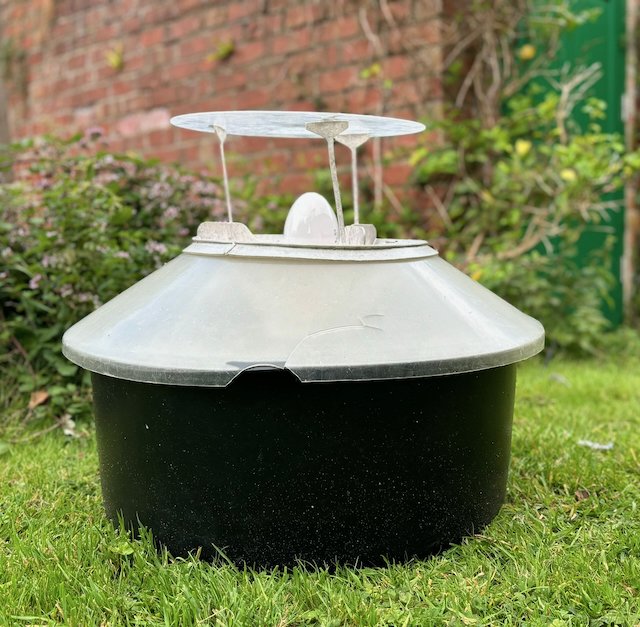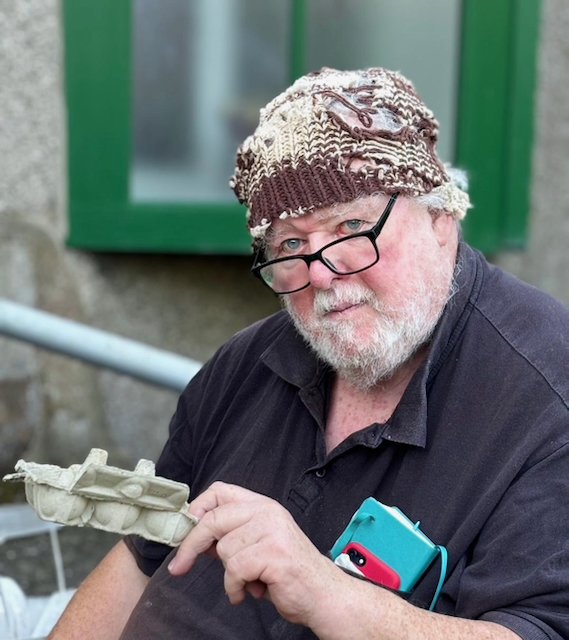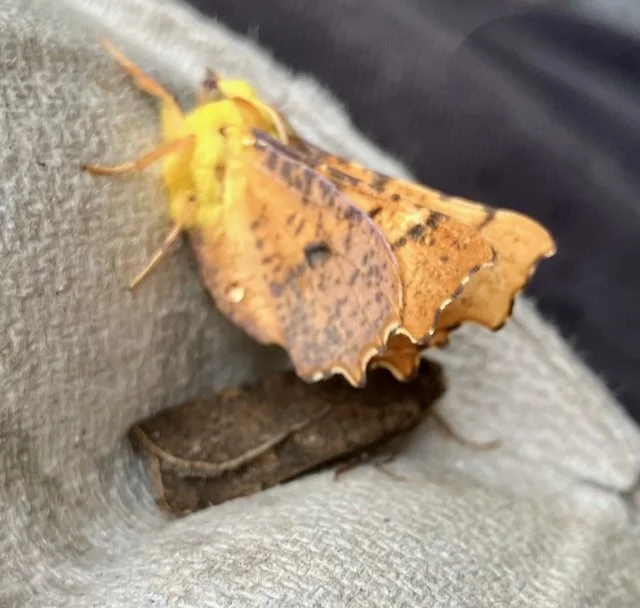The Moths of Sunderland Point
Garden Tiger
Pete Marsh, with others, has been collecting information on Moths at the Point for many years and is a familiar sight coming and going from number 12. In response to our suggestion, he has written this fascinating article.
My request to run a moth trap on a Bed and Breakfast holiday caused some alarm and an urgent call, ‘better get all the washing in.’ The reputation as serial sheet-shredders continues, although only one or two tiny species are responsible for the holes in your socks and jumpers. The overwhelming majority of moths are harmless and often colourful and charismatic.
Eyed Hawk-moth
Moth recording using light traps started at Sunderland Point with two single nights in 2005 and 2006. The latter, on September 23rd was a cameo. The trap was in a sheltered part of the Dolphin House lawn during a howling southerly and wind was dropping migrant moths from Africa and southern Europe like confetti.
Collecting information on moths on a regular basis began at number 21 when Hazel Moreby, husband John Ganly, and their son Tom (who was fascinated by moths) at Number 21 kindly allowed a 125-mercury vapour moth trap to operate from 2008-2011. When this property became unavailable in 2012, the Gilchrist family at Dolphin House were very welcoming to allow continuous recording.
Initially it was John Girdley, and then Jean Roberts and I have kept this going to the present day.
Elsewhere on the Point, when Tom Smith (senior) lived at number 3, his garden was occasionally used. Checks of the lights in the Toilet Block have been quite productive, especially at the ladies!
The most famous moth of the area, the Belted Beauty, frequenting the saltmarsh on the western side near Potts Corner, is covered in a separate article on the website.
Up to August 2024, about 20,000 records of c570 species from the various Sunderland Point area sites have been loaded onto the database.
Numbers of individuals included over 10,000 Large Yellow Underwing!
Habitat and therefore larval foodplants (specific plants chosen by types of moths to feed the caterpillar stage of life) play a huge part in the range of species encountered. The vast majority are ‘lowland generalists’ which have a wide range of larval foodplants.
Golden Plusia
Common ‘generalist’ species.
Examples of these dominant species in the usual order of appearance through the year (March-October) are Hebrew Character and Common Quaker, Small Square Spot, Light Brown Apple Moth, Flame Shoulder, Heart and Dart, Dark Arches, the ubiquitous Large Yellow Underwing, Common Rustic, the second brood of Small Square Spot and Setaceous Hebrew Character.
Scattered amongst the generalists on the egg cases in the trap (used egg cases are placed in the trap to give the moths somewhere to rest and settle down) are much more interesting species. These relate to the surrounding habitat, the prevailing wind direction and large-scale migratory events often associated with ‘Saharan dust.’
Opened trap with a few Moths and Crane Flies on egg cases (2nd Sept 2024)
Saltmarsh and other coastal species.
Saltmarsh and associated coastal upper shore vegetation occurs on both sides of the Point. Sometimes nationally rare and scarce species wander into the trap. These are species whose larvae feed on the specialist saltmarsh vegetation such as Scrobipalpa salicorniea from the Glasswort beds, Eucosma tripoliana from the swathes of Sea Aster. The larvae of Crescent-striped and the saltern grass-moth species, Pediasia aridella, feed on Puccinellia maritima, also known as Common Salt-marsh grass.
Crescent Striped
All these saltmarsh species are what might be described as ‘subtle’ or ‘unassuming,’ (meaning brown and featureless!) as camouflage amongst the sparse vegetation is the top priority.
By far the commonest coastal specialist is Dog’s Tooth with about 1,700 individuals in the traps. Also common but in smaller numbers are the Bordered Sallow from the plant Rest-harrow and Marbled Coronet and Tawny Shears found on Sea Campion.
Bordered Sallow
Tawny Shears
Drifted from the moors and other nearby sites.
The effect of wind direction on local movements is most obvious during easterlies. These can often produce strong katabatic winds (the movement of local, downward cool air) on the nearby fell-sides, leading to influxes of common moorland moths blown westwards and into lowland traps.
The most regular of these is True Lover’s Knot.
True Lover’s Knot
Migrants from southern Europe and North Africa.
More exciting are migrants from the Mediterranean or North Africa. By far the most common - recorded several hundred times - and often seen by day, is the Silver Y. Another day-flying migrant, the Hummingbird Hawk-moth, has been recorded at Sunderland at least three times.
Silver Y (below) and the Four-dotted Footman
Short video of the Hummingbird Hawk-moth: Credit Elizabeth Gilchrist
The large and spectacular, Convolvulus Hawk-moth graced the Dolphin House trap in 2023, in contrast, some of the migrants are tiny, notably Diamond-back Moth. Many of the rare migrants, such as Scarce Bordered Straw and Small Mottled Willow, are common Mediterranean pest species with the larvae given justifiably derogatory titles such as ‘beet army worm’ and subject to eradication programmes. Fortunately, they are unable to breed so far north!
Convolvulus Hawk-moth
Scarce Bordered Straw
Species spreading from the south.
The distribution of some species has changed, mostly species from further south spreading northwards and this is invariably initially along the coast. One example is Vine’s Rustic recorded 37 times at the Point since 2020. One or two species seem to have declined, most notably Feathered Ranunculus.
Vine’s Rustic
The pests.
There are one or two pests around, mainly on our fruit and veg with Cabbage Moth and Codling Moth self-explanatory. The latter and several other ‘apple bothering species' are regulars in the Dolphin House trap next to the orchard. The ubiquitous Brown House Moth is also a regular feature.
Unexpected oddities.
Finally, there have been some real puzzles. Moths which are not known migrants turning up miles away from known breeding sites, for example Brindled Ochre and especially Brussel’s Lace.
Brindled Ochre
Interestingly, there is a large lumbering creature called Lunar Hornet Clearwing Moth. This was ‘never seen in the field,’ even at the well-recorded Middleton Nature reserve. However, using pheromone lures, (mainly developed by Canterbury University and sold by suppliers such as Anglia Lepidopterist) have changed the distribution maps of what were previously, at best, very elusive species.
These lures replicate the scent emitted by female moths and can attract males from as far away as a mile or so in favourable winds! The Lunar Hornet Clearwing is known to be widespread wherever the long-leaved willow grows. So, could some of these ‘unexpected oddities’ possibly reflect an unknown breeding colony nearby?
Even after 16 years of regular recording new species are added quite frequently. If you live at the Point, it might be well-worth investing in a moth trap.
The Moth Trap at Dolphin House: Photo Katharine Gilchrist
Biography
Brought up in Lancashire attending Lancaster Royal Grammar School, thence being persuaded by paleo-ecologist Professor Frank Oldfield to enrol as an undergraduate at the newly-opened Ulster University. Subsequent career in a variety of teaching roles and, since 2000, as an ornithological consultant, followed by gradual retirement!
Main interests are moths, bird migration (ringer since 1968) and playing accordion.
Author wearing 45-year-old hat devastated by clothes moths, knitted by the legendary late Nancy Gull of Cley Cafe birdwatchers fame.
SP moth expert Pete Marsh: Photo Katharine Gilchrist
And a couple of irrestable bonus photos…
Dusky Thorn (below) and Angle Shades
Canary-shouldered Thorn
Many thanks Pete.
Pete sent this exciting news to us last night (Sunday October 6th) which we are pleased to add:
“Stop press
Radfords Flame Shoulder is one of a series of southern European moths which have moved north, first appearing in Britain in 1983, thence many years of occasional single figure catches in southern counties moth traps. It started to change in the early 2020s with Kent, for example, receiving 44 in 2021 following many years of occasional singles. This year has seen an explosion in numbers at southern and south-eastern sites with Portland Bird Observatory (Dorset) recently recording 242 in a single night and even the far south-west of Ireland getting in on the act with ones and twos on Cape Clear Island.
The north Midlands and north-west England have hitherto, however, been a step too far. Last night, however, saw quite fresh south easterly winds with at least one spell of rain ‘grounding’ high-flying migrant moths. In consequence the first for Northern Ireland was located, and a late trap check of the trap in the Dolphin House garden produced a ‘what’s this then’? from Jean Roberts who was checking the catch (she knew very well what it was 😊). This is unsurprisingly the first record for north-west England but quite possibly not the last on current trends”
Radfords Flame Shoulder



